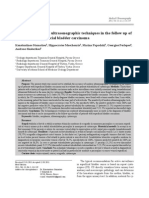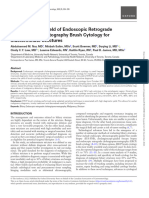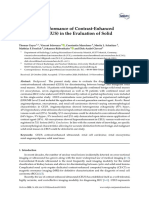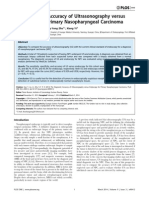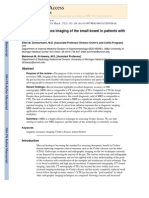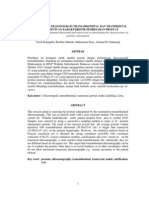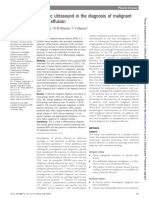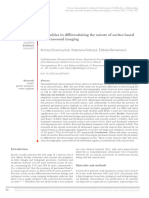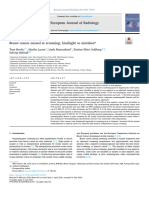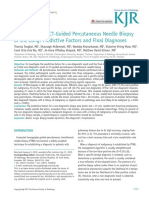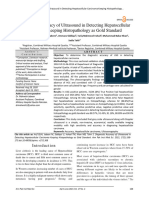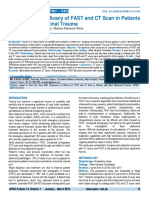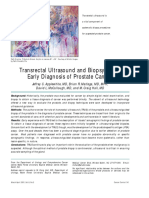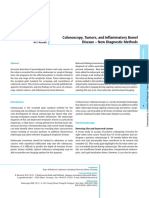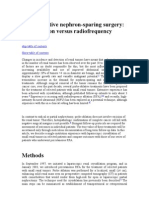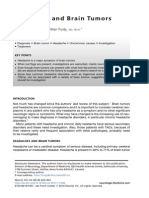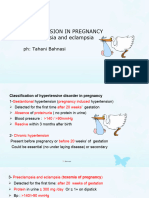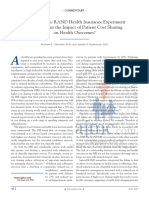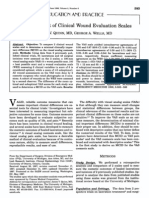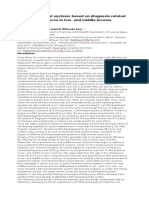Bladder 8
Bladder 8
Uploaded by
Duddy Ari HardiantoCopyright:
Available Formats
Bladder 8
Bladder 8
Uploaded by
Duddy Ari HardiantoOriginal Description:
Copyright
Available Formats
Share this document
Did you find this document useful?
Is this content inappropriate?
Copyright:
Available Formats
Bladder 8
Bladder 8
Uploaded by
Duddy Ari HardiantoCopyright:
Available Formats
The British Journal of Radiology, 84 (2011), 10911099
Accuracy of contrast-enhanced ultrasound in the detection of
bladder cancer
1
C NICOLAU, MD, 1L BUNESCH, MD, 2L PERI, MD, 1R SALVADOR, MD, 2J M CORRAL, MD, 3C MALLOFRE, MD
and 1C SEBASTIA, MD
1
Diagnostic Imaging Center and Departments of 2Urology and 3Pathology, Hospital Clinic, University of Barcelona,
Barcelona, Spain
Objective: To assess the accuracy contrast-enhanced ultrasound (CEUS) in bladder
cancer detection using transurethral biopsy in conventional cystoscopy as the reference
standard and to determine whether CEUS improves the bladder cancer detection rate
of baseline ultrasound.
Methods: 43 patients with suspected bladder cancer underwent conventional cystoscopy
with transurethral biopsy of the suspicious lesions. 64 bladder cancers were confirmed in
33 out of 43 patients. Baseline ultrasound and CEUS were performed the day before
surgery and the accuracy of both techniques for bladder cancer detection and number of
detected tumours were analysed and compared with the final diagnosis.
Results: CEUS was significantly more accurate than ultrasound in determining presence
or absence of bladder cancer: 88.37% vs 72.09%. Seven of eight uncertain baseline
ultrasound results were correctly diagnosed using CEUS. CEUS sensitivity was also better
than that of baseline ultrasound per number of tumours: 65.62% vs 60.93%. CEUS
sensitivity for bladder cancer detection was very high for tumours larger than 5 mm
(94.7%) but very low for tumours ,5 mm (20%) and also had a very low negative
predictive value (28.57%) in tumours ,5 mm.
Conclusion: CEUS provided higher accuracy than baseline ultrasound for bladder cancer
detection, being especially useful in non-conclusive baseline ultrasound studies.
Carcinoma of the urinary bladder is the most common
malignancy of the urinary tract that must be ruled out in
patients with haematuria with negative upper urinary
tract findings [1]. Cystoscopy remains the most sensitive
method of detecting bladder cancer, but has several
limitations: it is an invasive procedure; it is uncomfortable in some patients and it requires sedation or
anaesthesia. Conventional ultrasound (US) is one of the
imaging techniques used to screen for bladder cancer,
but with variable accuracy. The best results are obtained
using the latest equipment and new imaging tools
such as three-dimensional (3D) ultrasound [25]. Angiogenesis is essential to allow growth of malignancies,
and the detection of tumoural neovascularisation is one
of the keys of imaging modalities to achieve a definite
diagnosis. CT and MRI are accurate techniques for
bladder cancer detection when they are performed with
the injection of intravascular contrast agents. Detection
relies on the identification of bladder cancer neovascularisation and recent studies have shown high accuracy
with both techniques [6, 7]. The introduction of microbubble contrast agents and the development of contrast-specific software have increased the value of
ultrasound in the field of oncology [8, 9]. Ultrasound
contrast agents are strictly intravascular and are very sensitive in revealing tumour microvascularisation, helping
Address correspondence to: C Nicolau, Diagnostic Imaging Center,
Hospital Clinic, Villarroel 170, 08036 Barcelona, Spain. E-mail:
cnicolau@clinic.ub.es
The British Journal of Radiology, December 2011
Received 22 September
2009
Revised 21 March 2010
Accepted 13 April 2010
DOI: 10.1259/bjr/43400531
2011 The British Institute of
Radiology
in the detection and characterisation of malignancies [10
13]. Recently, the behaviour of bladder cancer has been
described after the administration of ultrasound contrast
agent, and its diagnosis relies on the detection of
hypervascular wall bladder thickening [14].
The aim of our study was to retrospectively assess the
value of contrast-enhanced ultrasound (CEUS) in bladder cancer detection in a selected high-risk group of
patients using transurethral biopsy in conventional
cystoscopy as the reference standard and to determine
whether CEUS improves the bladder cancer detection
rate of baseline ultrasound.
Methods
Patients
The study was approved by the Ethical Committee of
our institution and informed consent was obtained from
all study participants. From September 2007 to April 2008,
about 160 bladder tumours were diagnosed at our
hospital. From those patients with bladder tumours, we
selected a subgroup who were referred to the operating
theatre of the Department of Urology for conventional
cystoscopy under general anaesthesia. The selection of
this subgroup was at random, since it depended only
on the availability of the radiologists of the Radiology
Department to perform the ultrasound study on the
day prior to the surgical procedure. 43 non-consecutive
1091
C Nicolau, L Bunesch, L Peri et al
patients (ranging in age from 29 to 89 years, mean age
71.412.5 years) were included in this study. Flexible
cystoscopy was indicated because of the presence of
macroscopic haematuria (25 cases, 58.1%), surveillance
after transurethral resection (14 cases, 32.6%) and incidental sonographic findings (4 cases, 9.3%). When cystoscopically suspicious lesions were detected, transurethral
biopsies were performed and the final diagnoses were
obtained by histology.
All patients underwent blind baseline ultrasound and
CEUS the day before surgery. The urologists who
performed the cystoscopy did not know the results of
the previous ultrasound studies.
Imaging techniques
All ultrasound studies were performed by one of the
radiologists of the urogenital department who had at least
8 years of experience in ultrasound using Sequoia 512
equipment (Siemens Sequoia, Mountain View, CA). First
of all, a baseline ultrasound of the total bladder in
fundamental mode, using greyscale, was performed with
a multifrequency 4C1 convex array probe in order to
identify bladder wall thickening or bladder lesions.
Patients were instructed not to void for at least 1 h before
the ultrasound study and were not scanned until they had
the sensation of a full bladder in order to ensure good
bladder distension. After the baseline study, dynamic
CEUS of the whole bladder was performed using the
specific contrast software Cadence contrast pulse sequencing technology (CPS; Siemens, Erlangen, Germany),
which allows real-time evaluation of contrast agents with
minimum bubble destruction at low mechanical index
power levels. CPS was performed with the same convex
array probe, with a double focus in the area of interest,
using the following settings: insonating frequency,
3 MHz; acoustic power, 275 to 290 dB; frame rate, 17
20. A low mechanical index (,0.2) was used in order to
avoid microbubble disruption. CEUS studies were performed after the administration of 2.4 ml of Sonovue as a
bolus using a 21-gauge peripheral intravenous cannula
followed by a 5-ml saline flush.
Bladder wall enhancement was studied for up to 3 min.
Images and cineloops of baseline, arterial and venous
phases were selected and stored on digital cineloops by
the same radiologists who performed the ultrasound
studies for the off-line analysis after changing the names
of patients using a correlative code.
Imaging analysis
Two radiologists, each with at least 5 years of experience
in interpreting CEUS studies, independently interpreted the
acquired images and cineloops of the bladder off-line at least
3 weeks after the recruitment of patients. Both radiologists
were blinded to the final diagnosis, but they knew that
all patients were referred to cystoscopy because of a
diagnosis of bladder cancer by flexible cystoscopy. All
bladders were reviewed before and after contrast agent
injection. Reviewers were asked to identify, record the
presence, number and size and classify the location of
bladder tumours using the same classification of five
1092
segments used by the urologists on cystoscopy in our
centre (right lateral wall, left lateral wall, anterior wall
domus, fundus, posterior wallfloor). Ultrasound diagnoses of all discrepant studies were established by
consensus. In the baseline study, bladder cancer was
defined as the presence of focal bladder wall thickening or
the presence of focal masses protruding into the bladder
lumen. From the CEUS study, bladder cancer was defined
as the presence of focal hyperenhanced wall thickening or
enhancing masses that protrude into the bladder lumen. A
3-point scale was used for lesion detection using baseline
ultrasound and CEUS (1, absence of tumour; 2, presence
of bladder cancer; 3, results uncertain). The results of
baseline ultrasound and CEUS were compared with the
findings of conventional cystoscopy and biopsy, which
were considered the reference standard.
Statistical analysis
SPSS version 14.0 (SPSS, Chicago, IL) was used for
statistical analysis. Baseline characteristics of the patients
and bladder tumours are expressed as meanSE. The
relationship between the classification of cancer or absence
of cancer at baseline, CEUS and the final diagnosis were
analysed with the Fisher exact test. The overall sensitivity,
specificity, accuracy, positive predictive value and negative
predictive value for bladder cancer detection using ultrasound and CEUS were analysed by number of patients and
number of lesions. For the estimation of sensitivity,
uncertain results were classified as negative for cancer.
For the estimation of specificity, uncertain results were
classified as positive for cancer. A value of p,0.05 was
considered statistically significant.
Results
43 non-consecutive patients (36 men, 7 women) ranging
in age from 29 to 89 years (mean age 71.412.5 years) sent
to the operating theatre to undergo cystoscopy owing to
suspected bladder cancer were finally included in the
study. Reference standard tests (cystoscopy and biopsy)
revealed 64 bladder cancers in 33 out of 43 patients. All
cancers except one were transitional cell carcinomas.
The other was an undifferentiated carcinoma. Of the
10 patients without bladder cancer, absence of bladder
disease was confirmed by cystoscopy and biopsies in 7.
Biopsy of the other three patients showed chronic
inflammatory bladder wall changes (two cases) and a
papillary hyperplasia (one case). Of the 33 patients with
bladder cancer, the number of lesions in each bladder
detected by conventional cystoscopy was 1 in 22 patients,
and multifocal in 11 patients (range 27 lesions), with
a total of 64 bladder lesions. The size of the bladder
cancer lesions ranged from 0.3 to 7 cm, with a mean size
of 1.340.35 cm (1 tumour was not measured because of
diffuse occupation of the bladder). 39 tumours were larger
than 5 mm and the other 25 were 5 mm or less.
US/CEUS tumour detection
All US/CEUS studies were technically good and
considered suitable for diagnosis. Only one dose of
The British Journal of Radiology, December 2011
Accuracy of CEUS in the detection of bladder cancer
Figure 1. Flow diagram of baseline ultrasound based on Standards for Reporting of Diagnostic Accuracy. Two parameters
(presence or absence of bladder cancer and presence or absence with respect the total number of bladder cancers (in
parentheses) were evaluated in all patients.
contrast agent was necessary in all patients. Figures 1
and 2 summarise the results in the format of a Standards
for Reporting of Diagnostic Accuracy (STARD) flow
diagram [15]. Baseline ultrasound and CEUS were able to
detect tumours from 5 mm in size (Figure 3). Following
the established criteria, the baseline ultrasound suspicion
The British Journal of Radiology, December 2011
was of absence of tumour in 7 patients, presence of
bladder cancer in 28 patients and uncertain results in 8
patients. Causes of uncertain ultrasound results were
presence of bladder clots that could not be differentiated
from bladder cancer (two cases) and doubtful irregularity of the bladder wall without polypoid mass (six cases)
1093
C Nicolau, L Bunesch, L Peri et al
Figure 2. Flow diagram of contrast-enhanced ultrasound based on Standards for Reporting of Diagnostic Accuracy. Two
parameters (presence or absence of bladder cancer and presence or absence with respect to the total number of bladder cancers
(in parentheses) were evaluated in all patients.
(Figure 4). The final diagnosis of uncertain cases was
absence of cancer in five patients (included as ultrasound
false positives in our analysis) and presence of cancer in
three patients (included as false negatives in our
analysis). CEUS suspicion was of absence of tumour in
11 patients, presence of bladder cancer in 32 patients and
1094
uncertain results in 0 patients. All bladder cancers
identified with baseline ultrasound were also identified
with CEUS. The accuracy of baseline ultrasound in
bladder cancer detection per patient was 72.09% (31/
43 patients), with a sensitivity of 81.81% (27/33),
specificity of 40% (4/10), positive predictive value of
The British Journal of Radiology, December 2011
Accuracy of CEUS in the detection of bladder cancer
(a)
(b)
(c)
(d)
(e)
Figure 3. 62-year-old man with bladder cancer. (a) Greyscale baseline ultasound (US) of the bladder showed a 1 cm polypoid
mass on the left posterior wall of the bladder. (b) Contrast-enhanced (CE) ultrasound at 22 s showed early enhancement of the
polypoid lesion (arrow). Enhancement of the normal wall bladder (cap arrows) is almost imperceptible in the early arterial
phase. (c) CEUS at 40 s showed homogeneous enhancement of the polypoid lesion (arrow). Enhancement of the normal wall
bladder (cap arrows) is very tiny throughout the arterial and venous phases (Figure 1d) and cannot be differentiated from the
microvascularisation of the perivesical tissue. (d) CEUS at 120 s showed faint enhancement of the polypoid lesion. Enhancement
of the bladder wall is also faint at this time. (e) Cystoscopy confirmed the existence of a bladder wall tumour. Diagnosis by
biopsy (not shown) was urothelial bladder cancer.
The British Journal of Radiology, December 2011
1095
C Nicolau, L Bunesch, L Peri et al
(a)
(b)
(c)
Figure 4. 69-year-old man with suspicion of bladder cancer. (a) Baseline ultrasound (US) showed irregularity of the right
bladder wall that was suggestive but not conclusive of bladder cancer and classified as uncertain. (b) Contrast-enhanced (CE)
ultrasound at 42 s showed homogeneous enhancement of the bladder wall without focal masses, suggesting the absence of a
bladder tumour. (c) CEUS at 135 s did not show focal enhancing masses. Cystoscopy and bladder wall biopsies confirmed the
absence of bladder tumour.
81.81% (27/33) and negative predictive value of 40% (4/
10) (Figure 1). By contrast, the accuracy of CEUS to
detect bladder cancer per patient significantly increased
to 88.37% (38/43 patients), with a sensitivity of 90.9%
(30/33), specificity of 80% (8/10), positive predictive
value of 93.75% (30/32) and negative predictive value of
72.72% (8/11) (Figures 2 and 5). All bladder cancers
identified with baseline ultrasound were identified with
CEUS. Furthermore, CEUS was able to rule out the
presence or absence of bladder cancer in 87.5% (7/8) of
uncertain baseline US cases, with the detection of 3
bladder cancers not correctly identified by baseline
ultrasound. On analysing the accuracy of the technique
according to the number of bladder cancers detected, the
accuracy of baseline ultrasound was 58.1% (43/74) with
a sensitivity of 60.93% (39/64), specificity of 40% (4/10),
positive predictive value of 86.6% (39/45) and negative
predictive value of 13.79% (4/29) (Figure 1). By contrast,
the accuracy of CEUS according to the number of
1096
bladder cancers increased to 67.56% (50/74) with a
sensitivity of 65.62% (42/64), specificity of 80% (8/10),
positive predictive value of 95.45% (42/44) and negative
predictive value of 26.66% (8/30) (Figure 2).
There were only two false positive CEUS findings
for bladder cancer. The first was a patient with a growth
of the prostate mimicking a bladder tumour and the
other was a papillary hyperplasia, considered to be a
precursor lesion of bladder neoplasm by the World
Health Organization and the International Society of
Urological Pathologists [16], which was indistinguishable from bladder cancer by both CEUS and conventional cystoscopy. The false negative CEUS findings for
bladder cancer were 22 bladder cancers detected on
cystoscopy. 20 of these 22 were ,5 mm and were located
at the left lateral wall (n53), right lateral wall (n53),
domusanterior wall (n53), fundus (n55), or posterior
bladder wallfloor (n57), 2 of them at the bladder
neck. Only 2 sessile tumours larger than 5 mm (a 15-mm
The British Journal of Radiology, December 2011
Accuracy of CEUS in the detection of bladder cancer
(a)
(b)
(c)
(d)
Figure 5. 74-year-old man with bladder cancer. (a) Axial and (b) sagittal images of baseline ultrasound (US) that did not detect
bladder wall abnormalities. (c) Contrast-enhanced (CE) ultrasound at 90 s showed a homogeneous enhancing mass of 5 mm of
the left bladder wall (arrow). (d) Persistent enhancement of the small tumour was detected at 140 s (arrow). Urothelial bladder
cancer was confirmed by cystoscopy and resection.
tumour at the bladder fundus and a 10-mm tumour
at the left lateral wall) were missed. Therefore, CEUS
sensitivity for bladder cancer detection was significantly
higher for tumours larger than 5 mm, with a very low
sensitivity for bladder cancer #5 mm of 20% (5/25)
and a negative predictive value of 28.57% (8/28), which
rose to a sensitivity of 94.87% (37/39) and a negative
predictive value of 80% (8/10) for bladder cancer .5 mm
(Figure 6).
Discussion
This study demonstrates the high bladder cancer
detection rate of CEUS, which had a very high sensitivity
for the presence of bladder cancer per patient (90.9%).
Tumoural neovascularisation can be evaluated using
imaging modalities after the administration of contrast
agents and bladder cancer is a hypervascular tumour
that shows strong enhancement in the arterial phase,
The British Journal of Radiology, December 2011
followed by a plateau of enhancement and a slow
washout when evaluated with imaging modalities after
the administration of contrast agents [14, 1719]. Despite
conventional ultrasound currently being the preferred
non-invasive imaging technique for the screening of
bladder cancers, its accuracy depends on several factors,
including distension of the bladder, tumour size,
morphology and location of the lesions [2]. The main
limitation of ultrasound, which was found to be a factor
in the present study, is its low sensitivity in detecting
lesions smaller than 1 cm [3, 20]. CEUS sensitivity for the
number of detected bladder cancers was 65.5%, which
may be explained by the high number of tumours
#5 mm detected by cystoscopy (n525). These very small
tumours are usually flat and do not produce focal bladder
wall thickening or abnormal enhancement owing to the
absence of considerable neovascularisation, as has been
hypothesised in studies using other imaging techniques
[20]. Our results are slightly worse than those obtained
using CT or MRI with contrast agents [18, 2123], or using
1097
C Nicolau, L Bunesch, L Peri et al
(a)
(b)
Figure 6. 62-year-old man with multiple bladder cancers. (a) Baseline ultasound (US) showed three polypoid lesions on the
lateral bladder walls larger than 5 mm. (b) Contrast-enhanced (CE) ultrasound at 19 s showed the same number of polypoid
lesions of different sizes extending into the bladder lumen. At cystoscopy two more lesions smaller than 5 mm, not identified
using ultrasound or CEUS, were detected.
multidetector CT (MDCT) urography [2426]. In the study
by Kim et al [18], using MDCT, the detection rate was
97% for all bladder cancers and 85% for bladder cancers
smaller than 1 cm. However, all cancers detected in that
study were invasive and only 13 out of 77 were smaller than
1 cm. In a more recent study using dynamic contrastenhanced MDCT with multiplanar reconstructions, Jinzaki
et al [22] obtained an overall sensitivity of 90% and a sensitivity of 25% for bladder lesions 5 mm or smaller when
using 5-mm axial sections as the reconstruction protocol or a sensitivity of 58% using 2.5-mm axial sections
with a 1.25-mm overlap. With the use of MDCT urography,
Turney et al [25] and Sadow et al [26] found a sensitivity of
93% and 79%, respectively in detecting bladder cancer but
with a high number of equivocal (20% in the study by
Turney) or misinterpreted (9% in the study by Sadow)
studies.
With respect to location, we missed lesions from all
segments but especially on the bladder floor and fundus.
In the literature, there is no agreement regarding the
most difficult places to detect bladder cancers using
ultrasound. Those suggested include the anterior and
posterior bladder wall [3], the bladder neck or dome
areas [20] and the anterior wall [27]. Detection of small
tumours in the bladder floor can be a challenge in male
patients with benign prostatic hyperplasia (BPH) [2830]. A
large prostatic central gland protruding into the bladder
lumen can be difficult to differentiate from bladder cancer.
In our experience, bladder tumours enhance faster than the
normal prostate gland owing to its arterial neovascularisation, but intense enhancement in areas of benign
prostatic hyperplasia can be found using CEUS, mimicking
tumoural enhancement [31]. Another difficulty when
evaluating patients with BPH is the possibility of bladder
wall thickening with trabeculations, which in some cases
may mimic urothelial cancers.
When compared with baseline ultrasound, in our
study CEUS did not significantly improve the sensitivity
in detecting more bladder cancers, detecting only three
1098
lesions more. However, CEUS significantly increased the
accuracy of baseline ultrasound according to the presence
or absence of bladder tumour, especially in uncertain
baseline ultrasound cases. In clinical practice, several reasons such as the presence of bladder clots, surgical wall
changes, bladder wall trabeculation or the impossibility to
retain urine to totally distend the bladder may hamper
good visualisation of the bladder using baseline ultrasound. In our experience, CEUS is helpful in differentiating these entities from bladder cancer, detecting bladder
cancer neovascularisation enhancement [14].
One limitation of this study is the recruitment of patients
with high suspicion of bladder cancer obtained by flexible
cystoscopy who were to undergo rigid cystoscopy and the
absence of inclusion of healthy patients. However, radiologists who carried out the ultrasound and CEUS studies
and who reviewed the ultrasound and CEUS images did
not know the cystoscopic and histological results. With
the introduction of this recruitment bias, the real value of
CEUS as a screening for bladder cancer in patients with
haematuria cannot be provided.
In conclusion, CEUS improves the bladder cancer
detection rate of ultrasound, especially in ultrasound
studies that are non-conclusive.
References
1. Sutton JM. Evaluation of haematuria in adults. JAMA
1990;263:247580.
2. Francica G, Bellini SA, Scarano F, Miragliuolo A, De Marino
FA, Maniscalco M. Correlation of transabdominal sonographic and cystoscopic findings in the diagnosis of focal
abnormalities of the urinary bladder wall: a prospective
study. J Ultrasound Med 2008;27:88794.
3. Lopes RI, Nogueira L, Albertotti CJ, Takahashi DY, Lopes
RN. Comparison of virtual cystoscopy and transabdominal
ultrasonography with conventional cystoscopy for bladder
tumour detection. J Endourol 2008;22:17259.
4. Kocakoc E, Kiris A, Orhan I, Poyraz AK, Artas H, Firdolas F.
Detection of bladder tumours with 3-dimensional sonography
The British Journal of Radiology, December 2011
Accuracy of CEUS in the detection of bladder cancer
5.
6.
7.
8.
9.
10.
11.
12.
13.
14.
15.
16.
and virtual sonographic cystoscopy. J Ultrasound Med
2008;27:4553.
Mitterberger M, Pinggera GM, Neuwirt H, Maier E, Akkad
T, Strasser H, et al. Three-dimensional ultrasonography of
the urinary bladder: preliminary experience of assessment
in patients with haematuria. BJU Int 2007;99:11116.
Tuncbilek N, Kaplan M, Altaner S, Atakan IH, Sut N, Inci O,
et al. Value of dynamic contrast-enhanced MRI and
correlation with tumour angiogenesis in bladder cancer.
AJR Am J Roentgenol 2009;192:94955.
Park SB, Kim JK, Lee HJ, Choi HJ, Cho KS. Haematuria:
portal venous phase multi detector row CT of the bladder
a prospective study. Radiology 2007;245:798805.
Lencioni R, Della Pina C, Crocetti L, Bozzi E, Cioni D.
Clinical management of focal liver lesions: the key role
of real-time contrast-enhanced ultrasound. Eur Radiol
2007;17 (Suppl 6):F739.
Quaia E. Microbubble ultrasound contrast agents: an
update. Eur Radiol 2007;17:19952008.
Claudon M, Cosgrove D, Albrecht T, Bolondi L, Bosio M,
Calliada F, et al. Guidelines and good clinical practice
recommendations for contrast enhanced ultrasound
(CEUS)update 2008. Ultraschall Med 2008;29:2844.
Quaia E, Calliada F, Bertolotto M, Rossi S, Garioni L, Rosa
L, et al. Characterisation of focal liver lesions with contrast-specific ultrasound modes and a sulfur hexafluoridefilled microbubble contrast agent: diagnostic performance
and confidence. Radiology 2004;232:42030.
Albrecht T, Hohmann J, Oldenburg A, Skrok J, Wolf KJ.
Detection and characterisation of liver metastases. Eur
Radiol 2004;14 Suppl 8:P2533.
Nicolau C, Vilana R, Catala V, Bianchi L, Gilabert R,
Garcia A, et al. Importance of evaluating all vascular phases
on contrast-enhanced sonography in the differentiation
of benign from malignant focal liver lesions. AJR Am
J Roentgenol 2006;186:15867.
Nicolau C, Bunesch L, Sebastia C, Salvador R. Diagnosis
of bladder cancer: contrast-enhanced ultrasound. Abdom
Imaging 2010;35:494503.
Bossuyt PM, Reitsma JB, Bruns DE, Gatsonis CA, Glasziou
PP, Irwig LM, et al. Towards complete and accurate
reporting of studies of diagnostic accuracy: The STARD
Initiative. Radiology 2003;226:248.
Epstein JI, Amin MB, Reuter VR, Mostofi FK. The World
Health Organization/International Society of Urological
Pathology consensus classification of urothelial (transitional
cell) neoplasms of the urinary bladder. Bladder Consensus
Conference Committee. Am J Surg Pathol 1998;22:143548.
The British Journal of Radiology, December 2011
17. Mac Vicar AD. Bladder cancer staging. BJU Int 2000;86:11122.
18. Kim JK, Park SY, Ahn HJ, Kim CS, Cho KS. Bladder cancer:
analysis of multi-detector row helical CT enhancement
pattern and accuracy in tumour detection and perivesical
staging. Radiology 2004;231:72531.
19. Caruso G, Salvaggio G, Campisi A, Melloni D, Midiri M,
Bertolotto M, et al. Bladder tumor staging: comparison of
contrast-enhanced and gray-scale ultrasound. AJR Am J
Roentgenol 2010;194:1516.
20. Itzchak Y, Singer D, Fischelovitch Y. Ultrasonographic
assessment of bladder tumours. I. Tumour detection. J Urol
1981;126:313.
21. Barentsz JO, Jager GJ, van Vierzen PB. Staging urinary
bladder cancer after transurethral biopsy: value of fast
dynamic contrast-enhanced MR imaging. Radiology 1996;
201:18593.
22. Jinzaki M, Tanimoto A, Shinmoto H, Horiguchi Y, Sato K,
Kuribayashi S, et al. Detection of bladder tumours with
dynamic contrast-enhanced MDCT. AJR Am J Roentgenol
2007;188:913918.
23. Kim B, Semelka RC, Ascher SM, Chalpin DB, Carroll PR,
Hricak H. Bladder tumour staging: comparison of contrastenhanced CT, T1- and T2-weighted MR imaging, dynamic
gadolinium-enhanced imaging, and late gadoliniumenhanced imaging. Radiology 1994;193:239245.
24. Cohan RH, Caoili EM, Cowan NC, Weizer AZ, Ellis JH.
MDCT Urography: Exploring a new paradigm for imaging
of bladder cancer. AJR Am J Roentgenol 2009;192:15018.
25. Turney BW, Willatt JM, Nixon D, Crew JP, Cowan NC.
Computed tomography urography for diagnosing bladder
cancer. BJU Int 2006;98:3458.
26. Sadow CA, Silverman SG, OLeary MP, Signorovitch JE.
Bladder cancer detection with CT urography in an
Academic Medical Center. Radiology 2008;249:195202.
27. Ozden E, Turgut AT, Turkolmez K, Resorlu B, Safak M.
Effect of bladder carcinoma location on detection rates by
ultrasonography and computed tomography. Urology
2004;69:88992.
28. Wasserman NF. Benign prostatic hyperplasia: a review and
ultrasound classification. Radiol Clin North Am 2006;44:
689710.
29. Hsu TH, Matin SF. Benign prostatic hyperplasia mimicking
bladder tumour. Urology 2001;57:1166.
30. Wong JT, Wasserman NF, Padurean AM. Bladder squamous cell carcinoma. Radiographics 2004;24:855860.
31. Halpern EJ. Contrast-enhanced ultrasound imaging of
prostate cancer. Rev Urol 2006;8(Suppl 1):S29S37.
1099
You might also like
- Nurse Np1 Board CramsheetDocument8 pagesNurse Np1 Board CramsheetZero TwoNo ratings yet
- Final Compiled Submissions For LmorDocument40 pagesFinal Compiled Submissions For LmorAlana BridgemohanNo ratings yet
- In The Realm of Hungry Ghosts Close Encounters WitDocument2 pagesIn The Realm of Hungry Ghosts Close Encounters WitCaio Mello50% (2)
- 320-Drug and Alcohol Free Workplace ProgrammeDocument25 pages320-Drug and Alcohol Free Workplace ProgrammeKlinik MuliaNo ratings yet
- Comparative Evaluation of Ultrasonography and Computed Tomography in Pancreatic LesionsDocument13 pagesComparative Evaluation of Ultrasonography and Computed Tomography in Pancreatic LesionsMultan SohanhalwaNo ratings yet
- 05 StamatoiuDocument6 pages05 StamatoiuRinghio MaleficoNo ratings yet
- Diagnostic Parameters To Differentiate Benign From Malignant Ovarian Masses With Contrast-Enhanced Transvaginal SonographyDocument8 pagesDiagnostic Parameters To Differentiate Benign From Malignant Ovarian Masses With Contrast-Enhanced Transvaginal SonographyRush32No ratings yet
- gwacDocument6 pagesgwacJuan Pablo DiazNo ratings yet
- Jurnal IVUDocument7 pagesJurnal IVUshafarsoliNo ratings yet
- Role of Computed Tomography (CT) Scan in Staging of Cervical CarcinomaDocument6 pagesRole of Computed Tomography (CT) Scan in Staging of Cervical CarcinomaTriponiaNo ratings yet
- Medicina: Diagnostic Performance of Contrast-Enhanced Ultrasound (CEUS) in The Evaluation of Solid Renal MassesDocument8 pagesMedicina: Diagnostic Performance of Contrast-Enhanced Ultrasound (CEUS) in The Evaluation of Solid Renal MassesAgamNo ratings yet
- Ajr 10 4615Document7 pagesAjr 10 4615rizkiNo ratings yet
- Casadio Et Al 2013 - Urinary Cell Free DNA - Bladder CancerDocument7 pagesCasadio Et Al 2013 - Urinary Cell Free DNA - Bladder CancerManisha DassNo ratings yet
- Pone 0090412Document6 pagesPone 0090412Ratih Kusuma DewiNo ratings yet
- Ultrazvuk AbdomenaDocument10 pagesUltrazvuk AbdomenaLejlaNo ratings yet
- Bladder Tumor Markers Beyond Cytology in PDFDocument29 pagesBladder Tumor Markers Beyond Cytology in PDFMariana CreciunNo ratings yet
- Entero SequencesDocument12 pagesEntero SequencesKelvin SueyzyNo ratings yet
- Safety and Efficacy of Ultrasound-Guided Fiducial Marker Implantation For Cyberknife Radiation TherapyDocument7 pagesSafety and Efficacy of Ultrasound-Guided Fiducial Marker Implantation For Cyberknife Radiation TherapyAngelito SalinasNo ratings yet
- Javma-Javma 23 08 0458Document6 pagesJavma-Javma 23 08 0458Rajneesh SinghNo ratings yet
- Ajr 10 4865Document6 pagesAjr 10 4865ChavdarNo ratings yet
- Zheng Et Al., 2012Document6 pagesZheng Et Al., 2012soledadsaezNo ratings yet
- Abdominal computed tomography and exploratory laparotomy have high agreement in dogs with surgical diseaseDocument6 pagesAbdominal computed tomography and exploratory laparotomy have high agreement in dogs with surgical diseaseMichael JaffeNo ratings yet
- Peritonela TumorDocument6 pagesPeritonela TumorEuis Maya SaviraNo ratings yet
- The Diagnostic Accuracy of Abdominal Ultrasound Imaging For Detection of Ovarian MassesDocument5 pagesThe Diagnostic Accuracy of Abdominal Ultrasound Imaging For Detection of Ovarian MassesHanny TanzilNo ratings yet
- Capalbo 2015Document6 pagesCapalbo 2015nimaelhajjiNo ratings yet
- Correlation Transabdominal Ultrasound and Transrectal On Determining The Characteristics of Prostate EnlargementDocument9 pagesCorrelation Transabdominal Ultrasound and Transrectal On Determining The Characteristics of Prostate EnlargementWilliam TasidjawaNo ratings yet
- 114-Article Text-170-1-10-20180209Document6 pages114-Article Text-170-1-10-20180209Munazzah MehakNo ratings yet
- Urological Oncology: A Comparison Between Clinical and Pathologic Staging in Patients With Bladder CancerDocument5 pagesUrological Oncology: A Comparison Between Clinical and Pathologic Staging in Patients With Bladder CancerAmin MasromNo ratings yet
- Original ArticleDocument5 pagesOriginal ArticlehengkyNo ratings yet
- Usg Acute AppendicitisDocument10 pagesUsg Acute AppendicitisAtika RahmahNo ratings yet
- Virtual Colonoscopy Vs Conventional Colonoscopy in Patients at High Risk of Colorectal Cancer - A Prospective Trial of 150 PatientsDocument8 pagesVirtual Colonoscopy Vs Conventional Colonoscopy in Patients at High Risk of Colorectal Cancer - A Prospective Trial of 150 PatientsPari Pengda BaliNo ratings yet
- Endoscopic Ultrasound and Early Diagnosis of Pancreatic CancerDocument4 pagesEndoscopic Ultrasound and Early Diagnosis of Pancreatic CancerAchmad Dzulfikar AziziNo ratings yet
- Diagnostic Value of Combined Static-Excretory MR Urography in Children With HydronephrosisDocument9 pagesDiagnostic Value of Combined Static-Excretory MR Urography in Children With HydronephrosisnyimasNo ratings yet
- BJR 85 1029Document9 pagesBJR 85 1029Anna MariaNo ratings yet
- Journal Reading 2Document7 pagesJournal Reading 2Intan MayangsariNo ratings yet
- Lymph Nodes Esophageal Cancer Staging: Improved Accuracy by Endoscopic Ultrasound of CeliacDocument5 pagesLymph Nodes Esophageal Cancer Staging: Improved Accuracy by Endoscopic Ultrasound of CeliacPoonam JoshiNo ratings yet
- Esophageal Cancer Recurrence Patterns and Implicati 2013 Journal of ThoracicDocument5 pagesEsophageal Cancer Recurrence Patterns and Implicati 2013 Journal of ThoracicFlorin AchimNo ratings yet
- Jurnal UrologiDocument4 pagesJurnal UrologiTamara IstikharaNo ratings yet
- Role of Usg and CT Scan in Evaluating Ovarian Lesions: Submitted To:-Dr. Dharmendra DubeyDocument10 pagesRole of Usg and CT Scan in Evaluating Ovarian Lesions: Submitted To:-Dr. Dharmendra Dubeykajal rajNo ratings yet
- Ultrasonido PleuraDocument5 pagesUltrasonido PleuraJuan Pablo PérezNo ratings yet
- Bening Prostatic HyperplasiaDocument8 pagesBening Prostatic Hyperplasiajose salgadoNo ratings yet
- Imaging Diagnosis of Pancreatic Cancer: A State-Of-The-Art ReviewDocument15 pagesImaging Diagnosis of Pancreatic Cancer: A State-Of-The-Art ReviewTanwirul JojoNo ratings yet
- AscitesDocument5 pagesAscitesSylwester SowaNo ratings yet
- Ultrasound in Gynecology and ObstetricsDocument197 pagesUltrasound in Gynecology and ObstetricsAli Murtaza AbbasNo ratings yet
- Breast Cancer Missed at Screening Hindsight or MiDocument6 pagesBreast Cancer Missed at Screening Hindsight or MideaNo ratings yet
- 3.MRI of HCCDocument13 pages3.MRI of HCCOana AndreeaNo ratings yet
- Computed Tomography in The Diagnosis of Acute Appendicitis: Definitive or Detrimental?Document7 pagesComputed Tomography in The Diagnosis of Acute Appendicitis: Definitive or Detrimental?Blank SpaceNo ratings yet
- Jurnal Abdel GawadDocument9 pagesJurnal Abdel GawadSeptiana meta handayaniNo ratings yet
- Surgeon-Performed Ultrasound As A Diagnostic Tool in AppendicitisDocument6 pagesSurgeon-Performed Ultrasound As A Diagnostic Tool in Appendicitisansar ahmedNo ratings yet
- CHSJ 2012.2.5Document5 pagesCHSJ 2012.2.5Gabriel IonescuNo ratings yet
- Non-Diagnostic CT-Guided Percutaneous Needle BiopsyDocument12 pagesNon-Diagnostic CT-Guided Percutaneous Needle BiopsyHeru SigitNo ratings yet
- 368-Manuscript Word File (STEP 1) - 1722-1-10-20210720Document6 pages368-Manuscript Word File (STEP 1) - 1722-1-10-20210720Muhammad Babar KhanNo ratings yet
- Appendicitis Imaging: Practice EssentialsDocument6 pagesAppendicitis Imaging: Practice EssentialsAjp Ryuzaki CaesarNo ratings yet
- Journal 5Document4 pagesJournal 517.061 Kharismayanti FatimatuzzahroNo ratings yet
- Transrectal Ultrasound and Biopsy in The Early Diagnosis of Prostate CancerDocument10 pagesTransrectal Ultrasound and Biopsy in The Early Diagnosis of Prostate CancerHutri MahardikaNo ratings yet
- 2015 Article 269Document8 pages2015 Article 269Hiba MimineNo ratings yet
- Colonoscopy, Tumors, and Inflammatory Bowel Disease New Diagnostic MethodsDocument6 pagesColonoscopy, Tumors, and Inflammatory Bowel Disease New Diagnostic MethodsAnders AguilarNo ratings yet
- Probe-Ablative Nephron-Sparing Surgery: Cryoablation Versus Radiofrequency AblationDocument10 pagesProbe-Ablative Nephron-Sparing Surgery: Cryoablation Versus Radiofrequency AblationSubrata DasNo ratings yet
- Massa Ovarium Post MenopouseDocument4 pagesMassa Ovarium Post MenopouseAde Gustina SiahaanNo ratings yet
- 2009 PelvimetryDocument5 pages2009 PelvimetryayupurnamasariiNo ratings yet
- Ol 26 01 13872Document7 pagesOl 26 01 13872laura kazlauskaiteNo ratings yet
- Contribution of Endoscopic Ultrasound in Pancreatic MassesDocument6 pagesContribution of Endoscopic Ultrasound in Pancreatic MassesIJAR JOURNALNo ratings yet
- Contrast-Enhanced Ultrasound Imaging of Hepatic NeoplasmsFrom EverandContrast-Enhanced Ultrasound Imaging of Hepatic NeoplasmsWen-Ping WangNo ratings yet
- FromUltrasoundDiagnosist 2013Document4 pagesFromUltrasoundDiagnosist 2013Duddy Ari HardiantoNo ratings yet
- Rep GastroenterDocument5 pagesRep GastroenterDuddy Ari HardiantoNo ratings yet
- Cancer Presenting During Pregnancy: Radiological PerspectivesDocument15 pagesCancer Presenting During Pregnancy: Radiological PerspectivesDuddy Ari HardiantoNo ratings yet
- Headachesandbraintumors: Sarah Kirby,, R. Allan PurdyDocument10 pagesHeadachesandbraintumors: Sarah Kirby,, R. Allan PurdyDuddy Ari HardiantoNo ratings yet
- Safety of Radiographic Imaging During Pregnancy - American Family PhysicianDocument7 pagesSafety of Radiographic Imaging During Pregnancy - American Family PhysicianDuddy Ari HardiantoNo ratings yet
- Pregnancy and Brain TumourDocument10 pagesPregnancy and Brain TumourDuddy Ari HardiantoNo ratings yet
- When To Order Contrast-Enhanced CT - American Family PhysicianDocument9 pagesWhen To Order Contrast-Enhanced CT - American Family PhysicianDuddy Ari HardiantoNo ratings yet
- Policy ImplementationDocument4 pagesPolicy ImplementationAlyssa Mariae CodornizNo ratings yet
- Policy: PrisonDocument5 pagesPolicy: PrisonSakthivelParameswaranNo ratings yet
- RCOG Air Travel PregnancyDocument5 pagesRCOG Air Travel PregnancyElsaIsabelSilaenNo ratings yet
- NICABM Trauma20 Module1 GuideDocument2 pagesNICABM Trauma20 Module1 GuideSimone AraujoNo ratings yet
- Removing Medication From An AmpuleDocument2 pagesRemoving Medication From An AmpuleMichael Bon MargajaNo ratings yet
- Induction Policy, For Fcps-Ii Training & 2Nd Fellowship Session July 2022Document9 pagesInduction Policy, For Fcps-Ii Training & 2Nd Fellowship Session July 2022himayatullahNo ratings yet
- Food Service and Pharmacy, LaundryDocument19 pagesFood Service and Pharmacy, LaundryRAGAVI BNo ratings yet
- Ra 11463Document15 pagesRa 11463Elizabeth Dulla100% (1)
- LaaabbbbsssDocument3 pagesLaaabbbbsssshiva lakshmiNo ratings yet
- Accenture Five Branded Generics Strategies Pharmaceuticals in Emerging MarketsDocument16 pagesAccenture Five Branded Generics Strategies Pharmaceuticals in Emerging MarketsAnonymous 75aETJ8ONo ratings yet
- Impact of Ageing On Depression and Activities of Daily Livings in Normal Elderly Subjects Living in Old Age Homes and Communities of Kanpur, U.PDocument8 pagesImpact of Ageing On Depression and Activities of Daily Livings in Normal Elderly Subjects Living in Old Age Homes and Communities of Kanpur, U.PDr. Krishna N. SharmaNo ratings yet
- 04 Mecical Record and Abbreviation - FADocument28 pages04 Mecical Record and Abbreviation - FANur FitrianiNo ratings yet
- Susans ResumeDocument4 pagesSusans Resumeapi-415083061No ratings yet
- Preeclampsia and Eclampsia-1Document26 pagesPreeclampsia and Eclampsia-1Mohamed AdelNo ratings yet
- What Does The RAND Health Insurance ExperimentDocument3 pagesWhat Does The RAND Health Insurance ExperimentsunnyNo ratings yet
- Proactive Approaches To Safety ManagementDocument11 pagesProactive Approaches To Safety ManagementRubia Soraya RabelloNo ratings yet
- Wound ScaleDocument4 pagesWound ScaleHumam SyriaNo ratings yet
- Ayushman Bharat ProgrammeDocument14 pagesAyushman Bharat Programmesri sathya sai prashanth nalluriNo ratings yet
- ERP TET Area Eastern (Matra)Document3 pagesERP TET Area Eastern (Matra)Redi WardanaNo ratings yet
- Prnu 115 Portfolio Part D Assignment Final EditedDocument5 pagesPrnu 115 Portfolio Part D Assignment Final Editedapi-651790908No ratings yet
- Hospital Payment Systems Based On DiagnosisDocument16 pagesHospital Payment Systems Based On DiagnosisErma HandayaniNo ratings yet
- Reading Book Trauma Seventh Edition ReadDocument2 pagesReading Book Trauma Seventh Edition ReadPrisca AnindhitaNo ratings yet
- Ter Lya Ssess Ment 2Nd Term, S.Y .20 20 - 2 02: Health Allied StrandDocument20 pagesTer Lya Ssess Ment 2Nd Term, S.Y .20 20 - 2 02: Health Allied StrandMonalizaNo ratings yet
- Kenya ShitalCVDocument10 pagesKenya ShitalCVrmecopNo ratings yet
- Graduate CatlogDocument520 pagesGraduate CatlogPankajMahajanNo ratings yet
- Han Book 2009 FinalDocument61 pagesHan Book 2009 FinalTimothy JohnsonNo ratings yet





